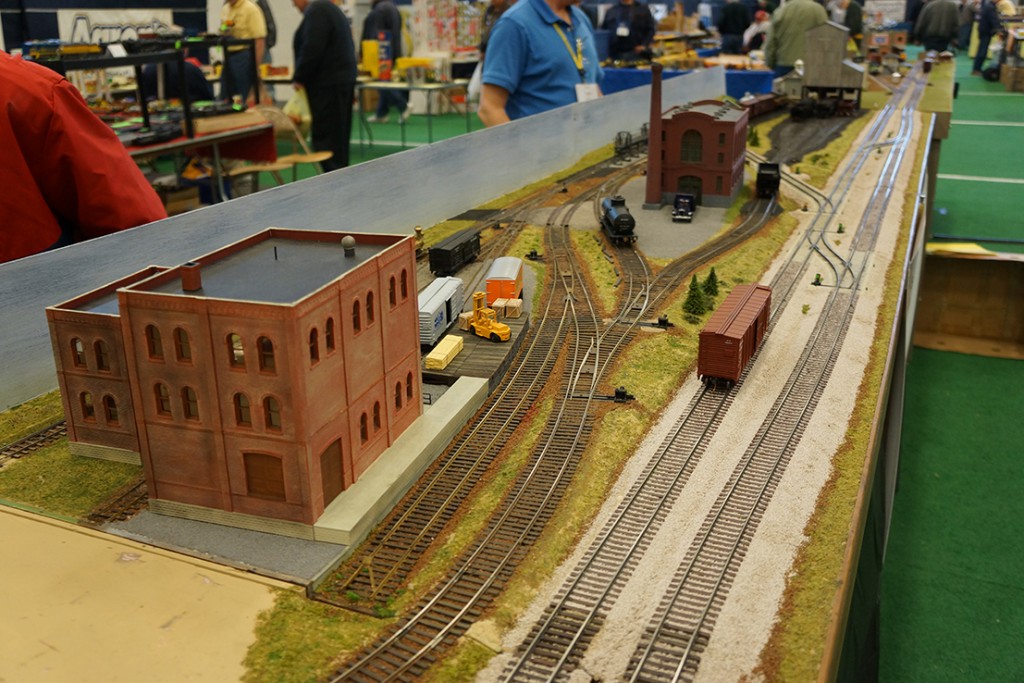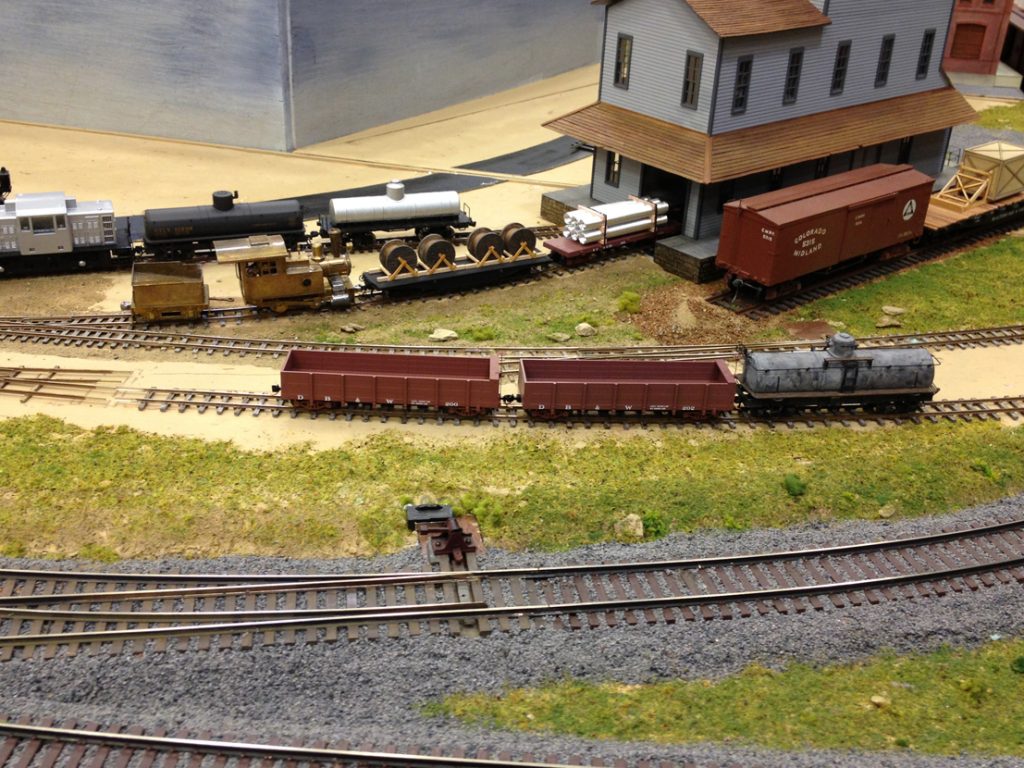The club’s modular switching layout consists of freelanced scenes representing southwestern Pennsylvania in and around the Pittsburgh area. The time setting is generally the early 1950s but equipment can be updated to the 1970s when desired.
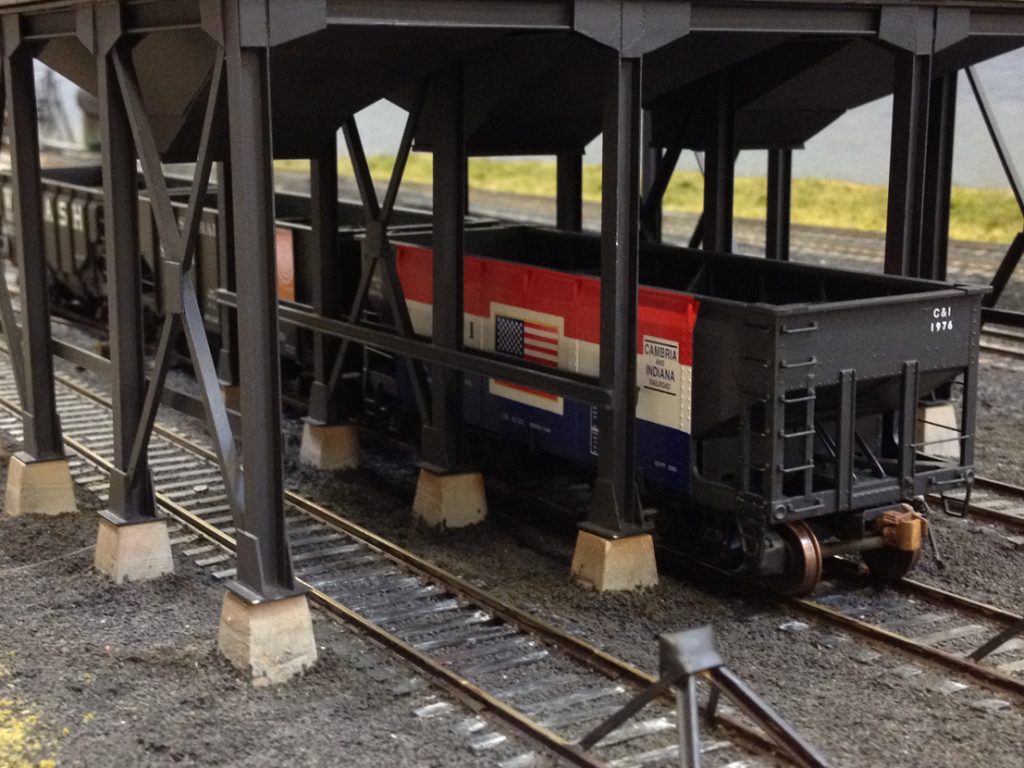
It’s 1976 now, and a freshly-painted Cambria & Indiana Bicentennial hopper car is spotted at the Library mine on the Montour Railroad. On the model, notice the immense improvement to the end of the SHS car by weathering the trucks and axles, buffing the wheel treads, painting the Kadee coupler and removing the shiny gladhand, and adding a rubber air hose by San Juan Car Company. Hopper car and photo © by Jim Whipple. Photo used by permission.
The layout is designed to interface with other modules following NASG S-Mod standards (railheads are 42” above the floor; if double-tracked, tracks are on 2.75” centers). All of the trackage can handle rolling stock with scale wheels (code 110 NASG/NMRA wheelsets); most PSG trackage can also handle hi-rail as the majority of turnouts are closed-frog switches or Tom’s Turnouts with the magic frog insert.
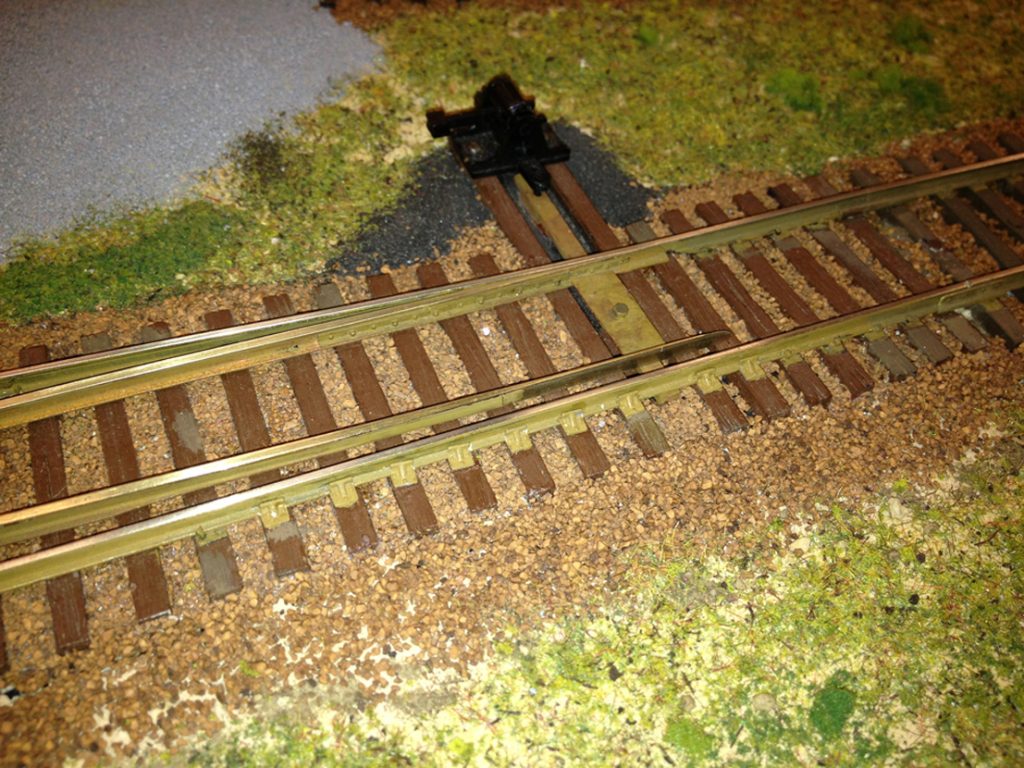
BK closed frog turnout, code 125 rail on wood ties and Ace nylon ties, handlaid by Jim Whipple. Detailed with altered San Juan Car Company rail braces and bolt detailing; weathered with Floquil paint.
The double-track main plus the junction module use S Helper Service/MTH code 138 flextrack, with a few pieces of sectional track. The industrial trackage is code 125 rail on Ace nylon ties with handlaid BK closed-frog turnouts. One siding and the coal yard are Tomalco code 100 track, with Shinohara #5 turnouts.
While the standard-gauge portion of the layout is generally operated with an NCE DCC system, flicking one switch can effect a change to AC or straight DC power.
An unusual feature of this layout is that since it was designed for “showing off” the potential of S scale at train meets and conventions, it includes trackage in four gauges in addition to standard gauge! In the back is a combined Sn3/Sn42 main line. The Sn3 line primarily showcases East Broad Top and Waynesburg & Washington equipment. The Sn42 third rail allows for Pittsburgh & Castle Shannon trains (actually built to the unique prototype gauge of 40”), and visiting Canadian equipment from Newfoundland. The third module includes a yard of Sn2, representing an industrial railway serving mills and warehouses. All the narrow-gauge lines run on straight DC power. And finally, there is a segment of trolley line built to “Pennsylvania broad-gauge,” 62.5 inches.
Structures come from a variety of sources. Altered “S” kits: wood frame warehouse by Altoona Model Works, kitbashed by Dave Felmley; switch towers by Bachmann (converted by Jim Whipple) and Mini-Structures (built by Gary Carmichael).
Converted HO structures (with altered windows, replacement doors, raised foundations): power house (Walthers), converted by Dave Felmley; freight house (Design Preservation), converted by Jon Knox; oil loading platform (Walthers), kitbashed by Jim Whipple.
And scratchbuilt: mine on Montour RR at Library PA, built by Dave Felmley; loading dock, also built by Dave Felmley.
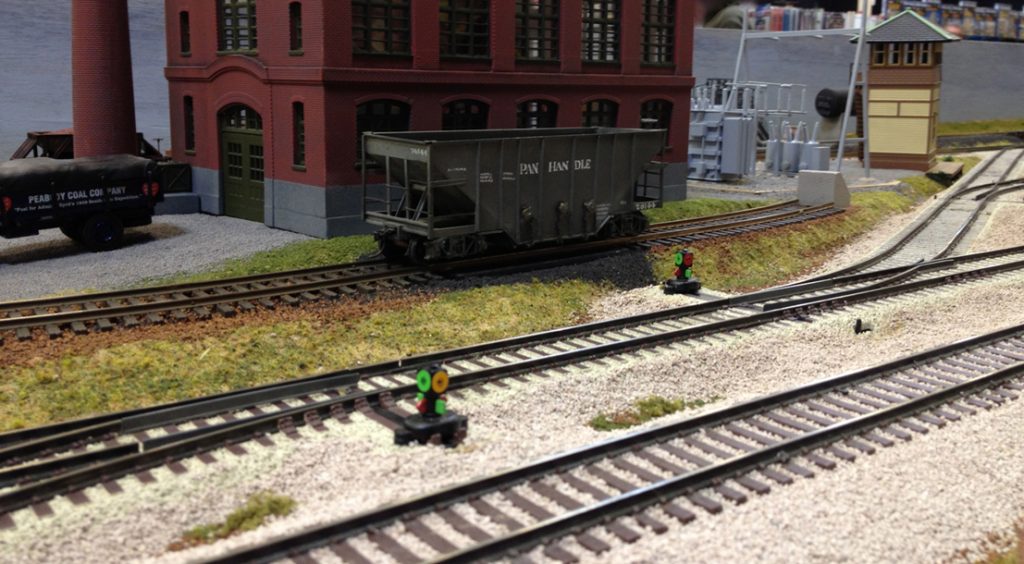
Completely scratch-built from styrene and hand-lettered, a hopper car by Chuck Courtney delivers a load of coal to the power plant, a Walthers HO building converted by Dave Felmley. Dave scratch-built the dumping bin under the track. In the background: transformer equipment (Walthers HO, converted by Jon Knox) and O/S Plasticville switch tower (converted and painted by Jim Whipple). In the foreground: SHS (now MTH) flextrack and turnouts.
The track plan was designed by Jim Whipple, inspired by the NASG promotional layout. Retired Conrail/NS engineer Gary Carmichael designs challenging switching tasks for operation competitions at conventions.
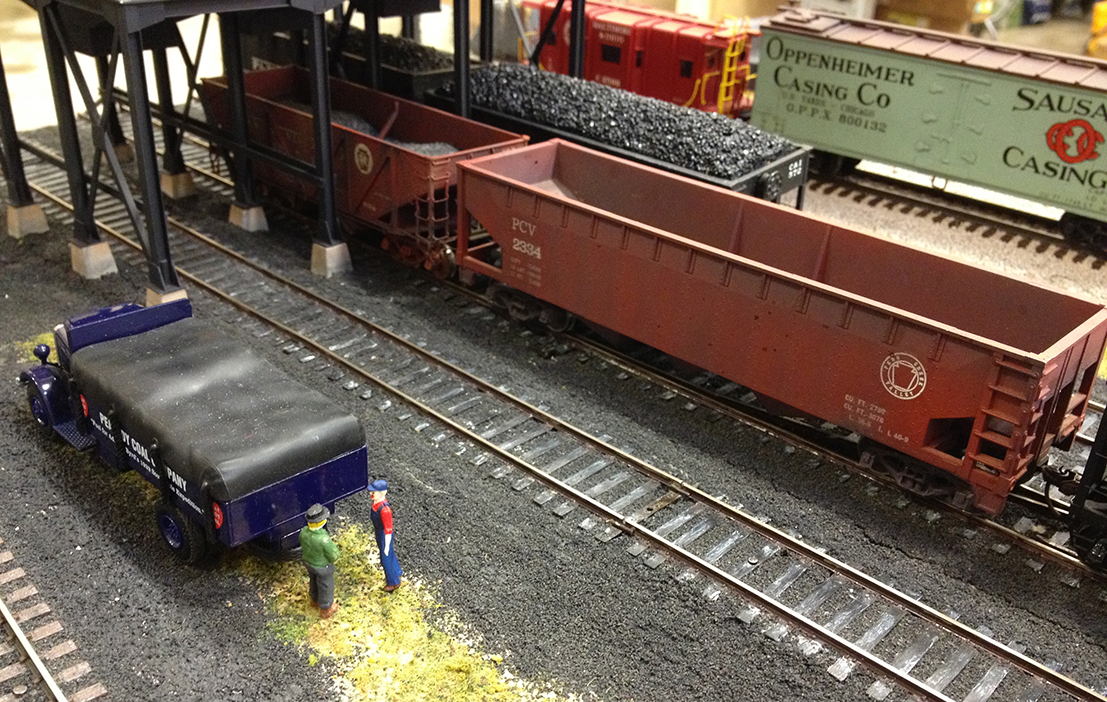
An interchange car from the Penn Creek Valley prompts a discussion between two workers on how the passing of the Penn Creek’s president, noted S modeler Sam Powell, prompted the moving of the entire railroad from Maryland to Pennsylvania! Photo © Jim Whipple. Used by permission.
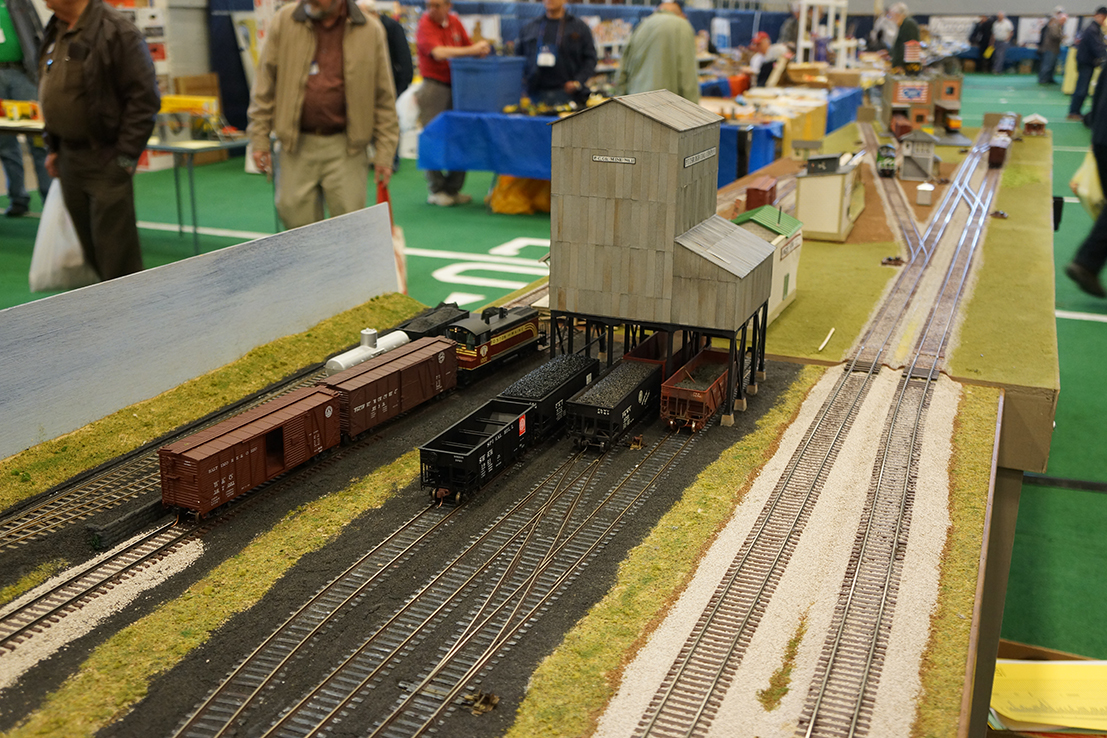
PSG layout connected to NASG modular display, creating a continuous 28-foot main line. The beauty of the S-Mod system is that modules can be connected to others from all over the country, either single- or double-track. At the 1990 NASG/NMRA joint convention in Pittsburgh, a 3300 foot S scale layout was assembled in the David Lawrence Convention Center! S-Mod units may be connected in loop or complex point-to-point systems. In many ways, it anticipated the philosophy of the Freemo module movement that came a decade later.
ABBREVIATIONS:
SHS = S Helper Service. Made product line of S trains and track now produced by: MTH = Mike’s Train House.
NASG = National Association of S Gaugers
NMRA = National Model Railroad Association
NS = Norfolk Southern, prototype contemporary railroad
Sn2 = 1:64 modeling of trains running on 2-foot gauge track
Sn3 = 1:64 modeling of trains running on 3-foot gauge track
Sn42 = 1:64 modeling of trains running on 42” (3.5-foot) gauge track
code 138 = model rail that is 0.138” high
code 125 = model rail that is 0.125” high, or 1/8 inch. This represents rail that is 8 inches high, generally welded (no joints every 39 feet), the heaviest rail currently used on freight mainlines and Amtrak’s Northeast Corrider.
code 100 = model rail that is 0.100” high. This was typical of jointed rail used in the early- and mid-twentieth century, and still found on branch lines, yards, and industrial spurs.

